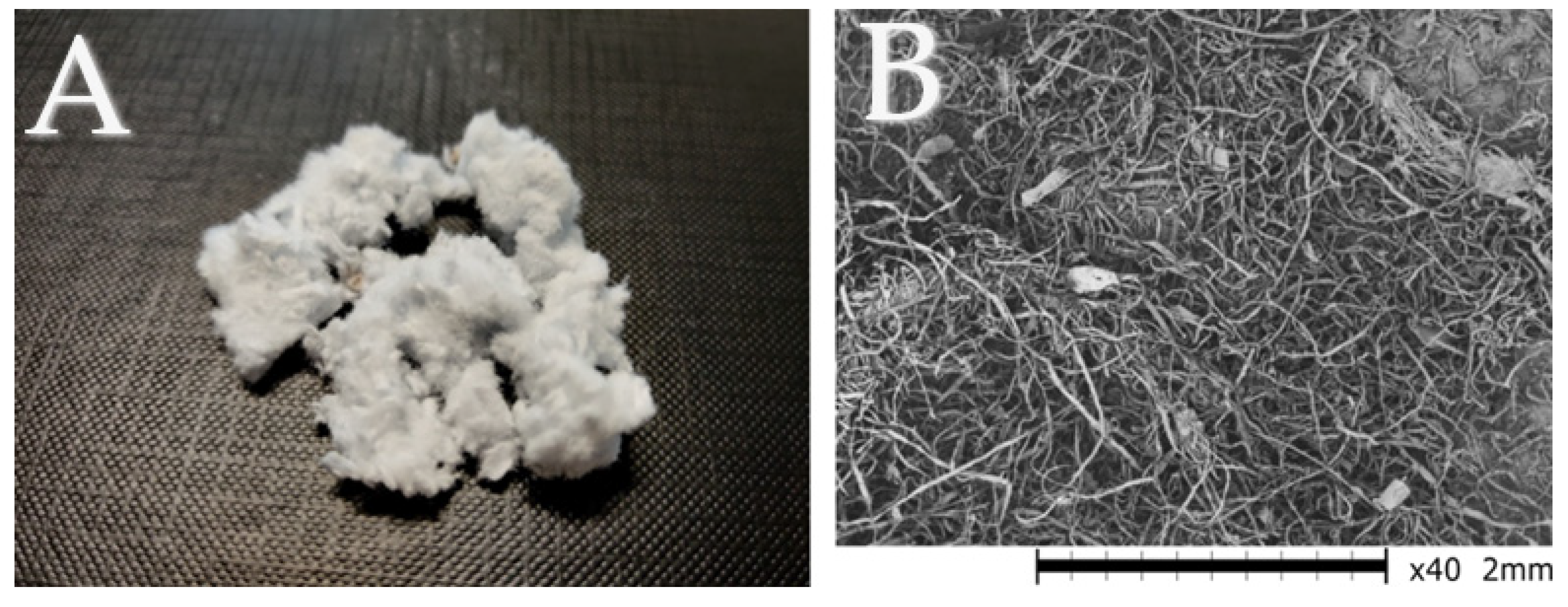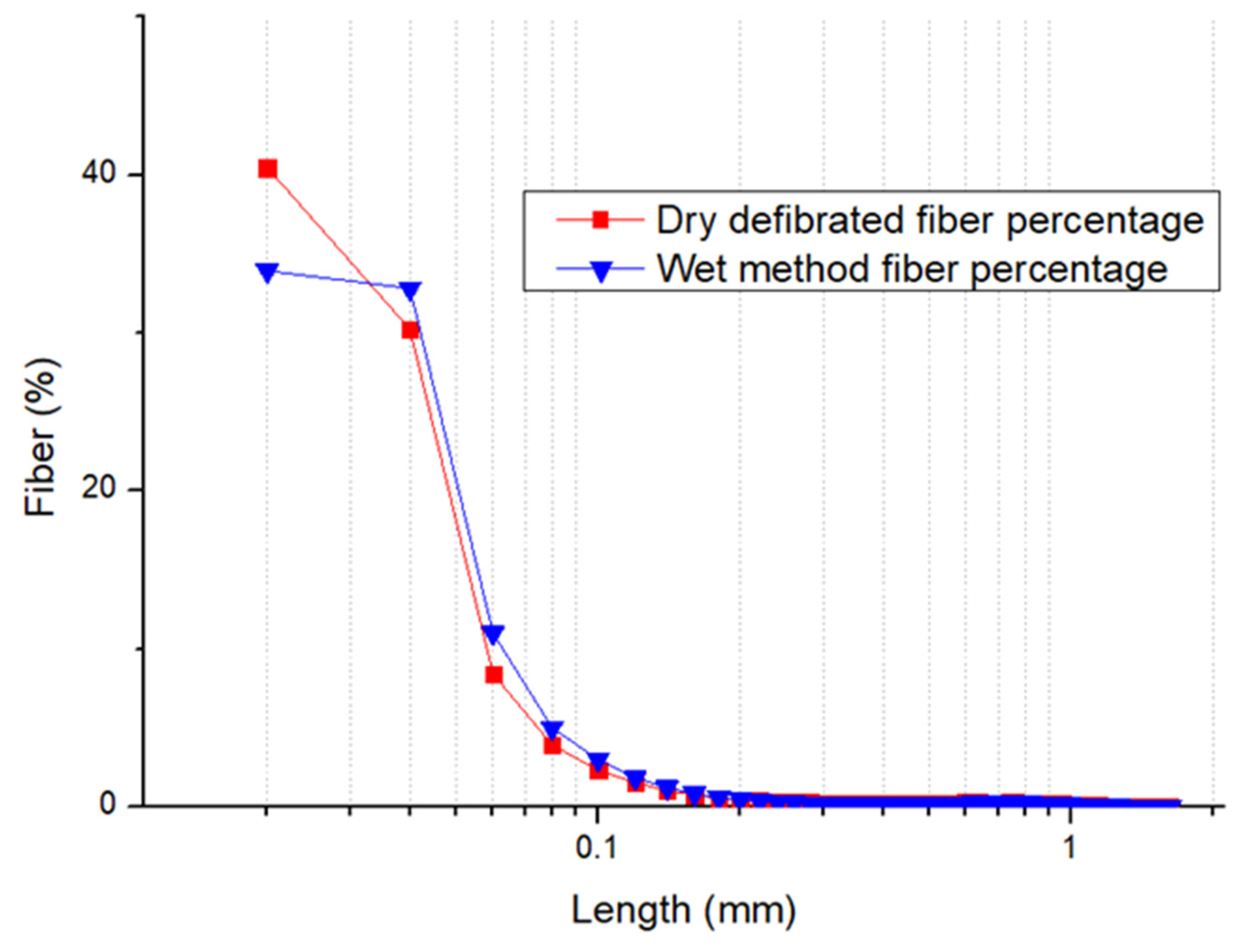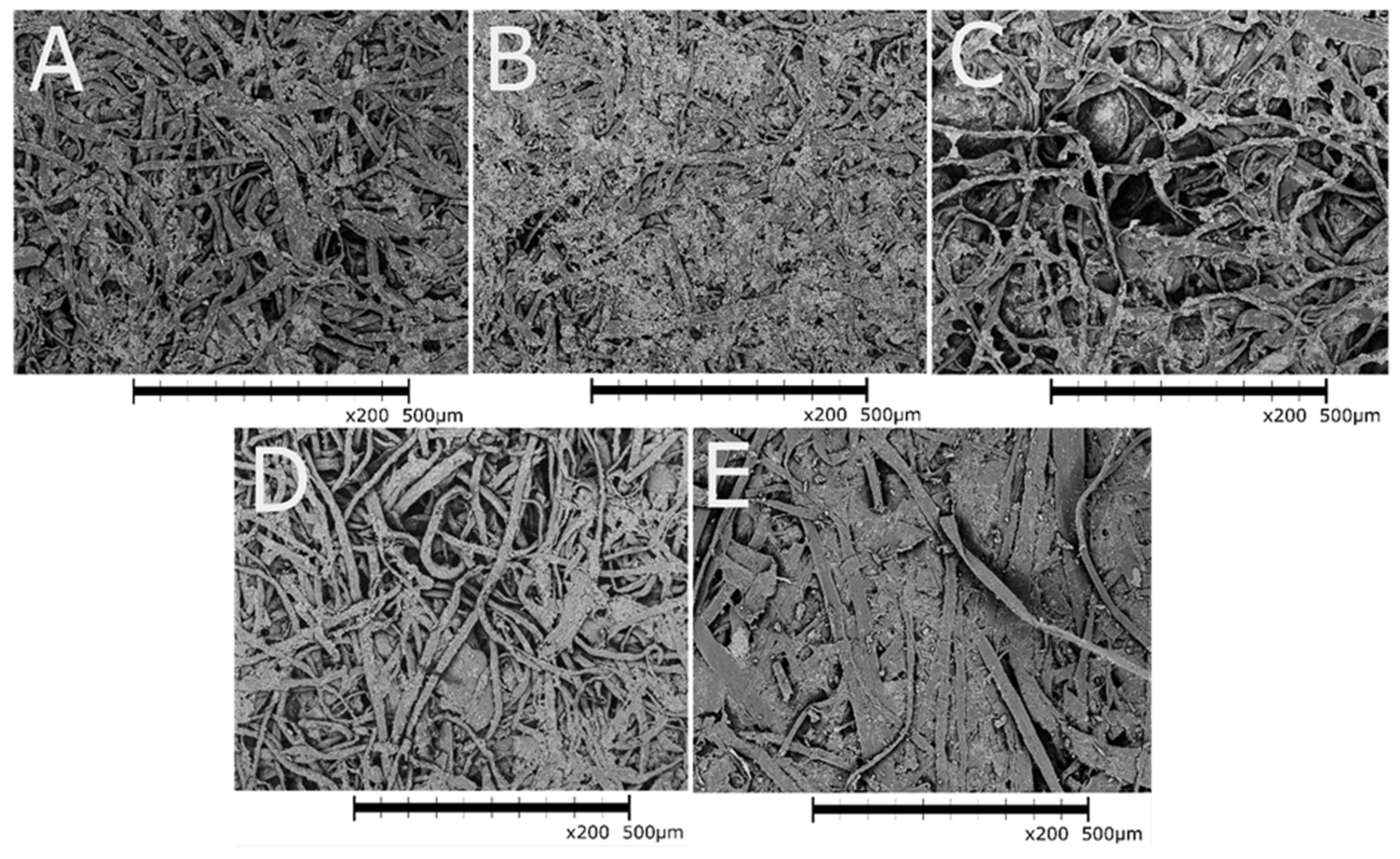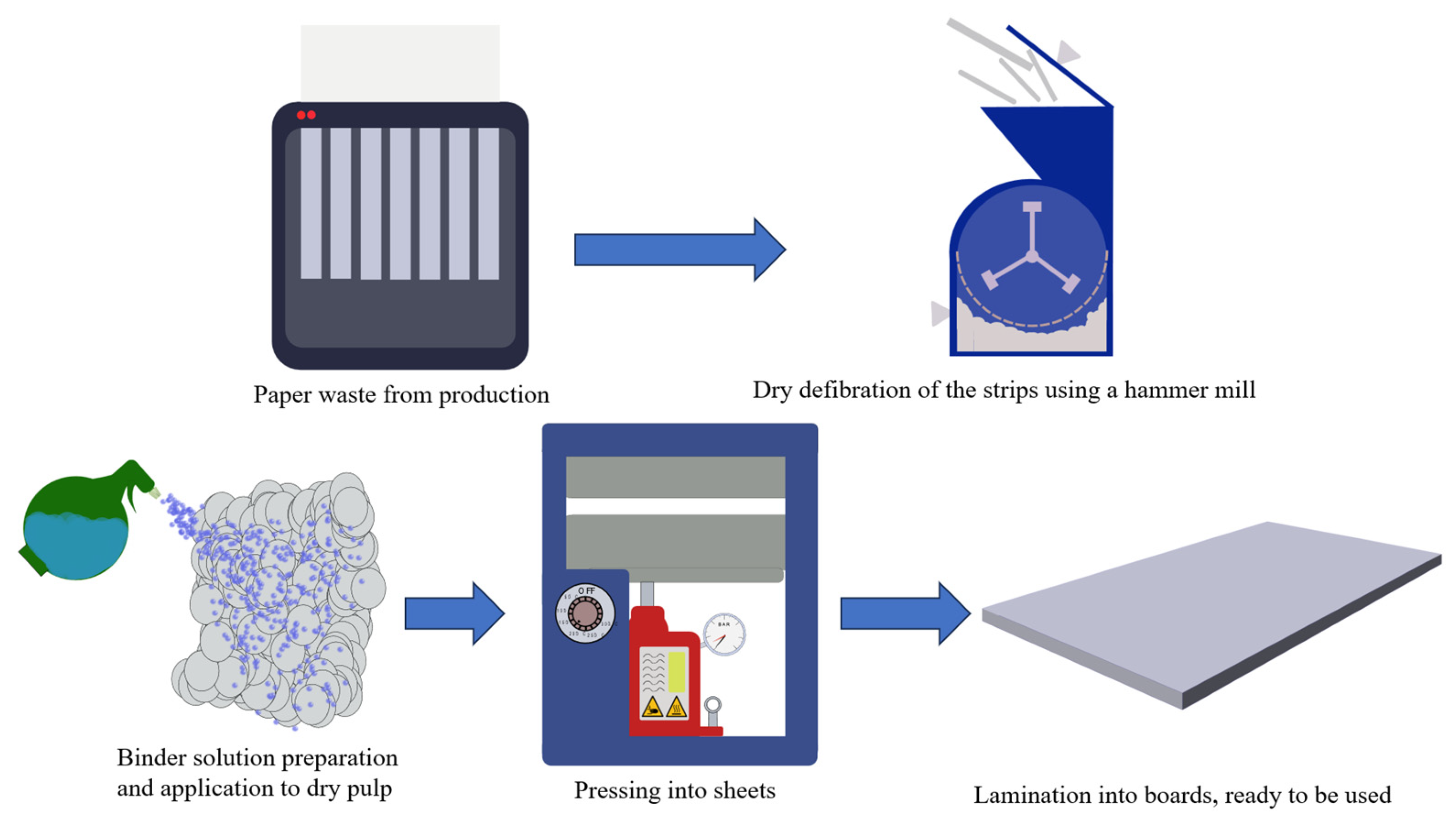Feasibility of a Sustainable On-Site Paper Recycling Process
Abstract
:1. Introduction
2. Results and Discussion
CO2 Footprint Analysis
3. Materials and Methods
3.1. Preparation of RCF Cardboard Samples
3.2. Dry Defibration
3.3. Binders
- 1% PVA solutions: 1.5%, 1.6%, 1.7%, and 1.8% (dry PVA per dry fiber)
- 2% PVA solutions: 3.0%, 3.2%, 3.4%, and 3.6% (dry PVA per dry fiber)
- 0.5% sodium alginate solutions: 0.75%, 0.8%, 0.85%, and 0.9% (dry alginate per dry fiber)
3.4. Forming of RCF Cardboards
3.5. Characterization
3.6. CO2 Footprint Analysis
4. Conclusions
Supplementary Materials
Author Contributions
Funding
Data Availability Statement
Conflicts of Interest
Abbreviations
| PVA | Poly(vinyl alcohol) |
| GHG | Greenhouse gas |
| SEM | Scanning electron microscope |
| RCF | Recycled cellulose fiber |
| CNF | Cellulose nanofiber |
References
- Van Ewijk, S.; Stegemann, J.A.; Ekins, P. Global Life Cycle Paper Flows, Recycling Metrics, and Material Efficiency. J. Ind. Ecol. 2018, 22, 686–693. [Google Scholar] [CrossRef]
- Laurijssen, J.; Marsidi, M.; Westenbroek, A.; Worrell, E.; Faaij, A. Paper and biomass for energy? Resour. Conserv. Recycl. 2010, 54, 1208–1218. [Google Scholar] [CrossRef]
- Bajpai, P. Paper and Paperboard Industry. In Pulp and Paper Industry; Elsevier: Amsterdam, The Netherlands, 2015; pp. 13–24. [Google Scholar] [CrossRef]
- Shang, D.; Lu, H.; Liu, C.; Wang, D.; Diao, G. Evaluating the green development level of global paper industry from 2000-2030 based on a market-extended LCA model. J. Clean. Prod. 2022, 380, 135108. [Google Scholar] [CrossRef]
- Amândio, M.S.T.; Pereira, J.M.; Rocha, J.M.S.; Serafim, L.S.; Xavier, A.M.R.B. Getting Value from Pulp and Paper Industry Wastes: On the Way to Sustainability and Circular Economy. Energies 2022, 15, 4105. [Google Scholar] [CrossRef]
- Molina-Sánchez, E.; Leyva-Díaz, J.C.; Cortés-García, F.J.; Molina-Moreno, V. Proposal of Sustainability Indicators for the Waste Management from the Paper Industry within the Circular Economy Model. Water 2018, 10, 1014. [Google Scholar] [CrossRef]
- Lipiäinen, S.; Kuparinen, K.; Sermyagina, E.; Vakkilainen, E. Pulp and paper industry in energy transition: Towards energy-efficient and low carbon operation in Finland and Sweden. Sustain. Prod. Consum. 2022, 29, 421–431. [Google Scholar] [CrossRef]
- IEA. Tracking Clean Energy Progress 2023. Paris, Jul. 2023. Available online: https://www.iea.org/reports/tracking-clean-energy-progress-2023 (accessed on 20 April 2024).
- Sopelana, A.; Auriault, C.; Bansal, A.; Fifer, K.; Paiva, H.; Maurice, C.; Westin, G.; Rios, J.; Oleaga, A.; Cañas, A. Innovative Circular Economy Models for the European Pulp and Paper Industry: A Reference Framework for a Resource Recovery Scenario. Sustainability 2021, 13, 10285. [Google Scholar] [CrossRef]
- Recovered Paper and Recycled Fibers. In Handbook of Pulp; Wiley-VCH: Weinheim, Germany, 2006; pp. 1147–1190.
- Olejnik, K. Water Consumption in Paper Industry—Reduction Capabilities and the Consequences. In Security of Industrial Water Supply and Management; Atimtay, A.T., Sikdar, S.K., Eds.; NATO Science for Peace and Security Series C: Environmental Security; Springer: Dordrecht, The Netherlands, 2011; pp. 113–129. [Google Scholar] [CrossRef]
- Han, N.; Zhang, J.; Hoang, M.; Gray, S.; Xie, Z. A review of process and wastewater reuse in the recycled paper industry. Environ. Technol. Innov. 2021, 24, 101860. [Google Scholar] [CrossRef]
- Jacobs. Pulp and Paper Industry: Energy Bandwidth Study, USA. 2006. Available online: https://www.energy.gov/eere/amo/articles/itp-forest-products-report-aiche-pulp-and-paper-industry-energy-bandwidth-study (accessed on 5 May 2024).
- Pivnenko, K.; Eriksson, E.; Astrup, T.F. Waste paper for recycling: Overview and identification of potentially critical substances. Waste Manag. 2015, 45, 134–142. [Google Scholar] [CrossRef]
- Nakamura, M. Development of The Dry Paper Recycling Technology which Realizes a New Ofice Papermaking System. Jpn. TAPPI J. 2018, 72, 786–792. [Google Scholar] [CrossRef]
- CEPI. DryPulp for Cureformed Paper. EP2876207A1, 27 May 2015. Available online: https://patents.google.com/patent/EP2876207A1/en (accessed on 10 November 2023).
- Georgiadis, P. An integrated System Dynamics model for strategic capacity planning in closed-loop recycling networks: A dynamic analysis for the paper industry. Simul. Model. Pract. Theory 2013, 32, 116–137. [Google Scholar] [CrossRef]
- Flory, A.R.; Requesens, D.V.; Devaiah, S.P.; Teoh, K.T.; Mansfield, S.D.; E Hood, E. Development of a green binder system for paper products. BMC Biotechnol. 2013, 13, 28. [Google Scholar] [CrossRef] [PubMed]
- Rizzi, P.; Danesi, S. Policies for the Circular Economy: The Case of Paper Industry. Symphonya 2021, 1, 76–84. [Google Scholar] [CrossRef]
- Merrild, H.; Damgaard, A.; Christensen, T.H. Life cycle assessment of waste paper management: The importance of technology data and system boundaries in assessing recycling and incineration. Resour. Conserv. Recycl. 2008, 52, 1391–1398. [Google Scholar] [CrossRef]
- Yang, G.; Zhou, C.; Wang, W.; Ma, S.; Liu, H.; Liu, Y.; Zhao, Z. Recycling sustainability of waste paper industry in Beijing City: An analysis based on value chain and GIS model. Waste Manag. 2020, 106, 62–70. [Google Scholar] [CrossRef]
- Kvasha, N.; Bolotnikova, O.; Malevskaia-Malevich, E. Biotechnological Basis of the Pulp and Paper Industry Circular Economic System. Economies 2023, 11, 302. [Google Scholar] [CrossRef]
- Gregor-Svetec, D.; Možina, K.; Blaznik, B.; Urbas, R.; Brodnjak, U.V.; Golob, G. “Efficient Paper Recycling”, University of Ljubljana, Faculty of Natural Sciences and Engineering, Ljubljana, Slovenia. 2013. Available online: https://dk.upce.cz/server/api/core/bitstreams/b6b1022f-db19-4a5b-a2b8-8d80a4d88d59/content (accessed on 4 April 2025).
- Worrell, E.; Martin, N.; Anglani, N.; Einstein, D.; Khrushch, M.; Price, L. Opportunities to Improve energy Efficiency in the U.S. Pulp and Paper Industry; Lawrence Berkeley National Laboratory: Berkeley, CA, USA, 2001. [Google Scholar]
- Li, L.; Zhu, J.; Zeng, Z. New Approach for Recycling Office Waste Paper: An Efficient and Recyclable Material for Oily Wastewater Treatment. ACS Appl. Mater. Interfaces 2020, 12, 55894–55902. [Google Scholar] [CrossRef]
- Jin, E.; van Ewijk, S.; Kanaoka, K.S.; Alamerew, Y.A.; Lin, H.; Cao, Z.; Jabarivelisdeh, B.; Ehmann, K.F.; Chertow, M.R.; Masanet, E. Sustainability assessment and pathways for U.S. domestic paper recycling. Resour. Conserv. Recycl. 2023, 199, 107249. [Google Scholar] [CrossRef]
- Ono, Y.; Hayashi, M.; Yokoyama, K.; Okamura, T.; Itsubo, N. Environmental Assessment of Innovative Paper Recycling Technology Using Product Lifecycle Perspectives. Resources 2020, 9, 23. [Google Scholar] [CrossRef]
- Altay, B.N.; Klass, C.; Chen, T.; Fleck, A.; Aydemir, C.; Karademir, A.; Fleming, P.D. The effect of green biobased binder on structural, mechanical, liquid absorption and wetting properties of coated papers. Clean. Eng. Technol. 2021, 5, 100274. [Google Scholar] [CrossRef]
- Chen, Q.; Zuo, W.; Xie, Z.; Liu, W.; Lu, M.; Qiu, X.; Habib, S.; Jing, Y.; Zhang, X.; Yu, N.; et al. Design of sodium alginate/PVA based high-efficiency recycled rewritten film by water-soluble-regeneration. Cellulose 2023, 30, 7865–7875. [Google Scholar] [CrossRef]
- Defalque, C.M.; Marins, F.A.S.; da Silva, A.F.; Rodríguez, E.Y.A. A review of waste paper recycling networks focusing on quantitative methods and sustainability. J. Mater. Cycles Waste Manag. 2021, 23, 55–76. [Google Scholar] [CrossRef]
- Shen, J.; Zhang, M. Disassembly, refinement, and reassembly: From ancient papermaking to modern materials processing. J. Bioresour. Bioprod. 2025, 10, 7–13. [Google Scholar] [CrossRef]
- Yang, X.; Berglund, L.A. Recycling without Fiber Degradation—Strong Paper Structures for 3D Forming Based on Nanostructurally Tailored Wood Holocellulose Fibers. ACS Sustain. Chem. Eng. 2020, 8, 1146–1154. [Google Scholar] [CrossRef]
- Seth, R. Fibre Quality Factors in Papermaking—II The Importance of Fibre Coarseness. MRS Proc. 1990, 197, 143. [Google Scholar] [CrossRef]
- Mazur, K.; Buchner, R.; Bonn, M.; Hunger, J. Hydration of Sodium Alginate in Aqueous Solution. Macromolecules 2014, 47, 771–776. [Google Scholar] [CrossRef]
- Chang, C.; Duan, B.; Zhang, L. Fabrication and characterization of novel macroporous cellulose–alginate hydrogels. Polymer 2009, 50, 5467–5473. [Google Scholar] [CrossRef]
- Shivyari, N.Y.; Tajvidi, M.; Bousfield, D.W.; Gardner, D.J. Production and Characterization of Laminates of Paper and Cellulose Nanofibrils. ACS Appl. Mater. Interfaces 2016, 8, 25520–25528. [Google Scholar] [CrossRef]
- Amini, E.; Tajvidi, M.; Gardner, D.J.; Bousfield, D.W. Utilization of Cellulose Nanofibrils as a Binder for Particleboard Manufacture. BioResources 2017, 12, 4093–4110. [Google Scholar] [CrossRef]
- Antony, T.; Cherian, R.M.; Varghese, R.T.; Kargarzadeh, H.; Ponnamma, D.; Chirayil, C.J.; Thomas, S. Sustainable green packaging based on nanocellulose composites-present and future. Cellulose 2023, 30, 10559–10593. [Google Scholar] [CrossRef]
- Provost-Savard, A.; Legros, R.; Majeau-Bettez, G. Parametrized regionalization of paper recycling life-cycle assessment. Waste Manag. 2023, 156, 84–96. [Google Scholar] [CrossRef]
- Pihkola, H. Carbon Footprint and Environmental Impacts of Print Products from Cradle to Grave. Results from the LEADER Project (Part 1); VTT: Espoo, Finland, 2010. [Google Scholar]
- Organisatsioonide KHG Jalajälg | Kliimaministeerium. Available online: https://kliimaministeerium.ee/rohereform-kliima/rohereform/organisatsioonide-khg-jalajalg (accessed on 28 August 2024).
- Bastos, J.; Monforti-Ferrario, F.; Melica, G. GHG Emission Factors for Local Energy Use. January 2024. Available online: http://data.europa.eu/89h/72fac2b2-aa63-4dc1-ade3-4e56b37e4b7c (accessed on 28 August 2024).
- Kiilto. Kiilto Sustainability Report 2023. 2023. Available online: https://www.kiilto.com/wp-content/uploads/2024/04/kiilto_sustainability_report_2023.pdf (accessed on 20 January 2025).
- Greenhouse Gas Reporting: Conversion Factors. 2024. Available online: https://www.gov.uk/government/publications/greenhouse-gas-reporting-conversion-factors-2024 (accessed on 20 January 2025).
- Singh, V.; Bachala, S.K.; Madan, M.; Ahuja, A.; Rastogi, V.K. A comprehensive comparison between synthetic and bio-based wet-strength additives for paper manufacturing. Cellulose 2024, 31, 4645–4679. [Google Scholar] [CrossRef]
- ISO 16065-2:2014(E); ISO, Pulps—Determination of Fibre Length by Automated Optical Analysis — Part 2: Unpolarized Light Method. ISO: Geneva, Switzerland, 2014.
- ISO 5263-1:2004(E); ISO, Pulps—Laboratory Wet Disintegration — Part 1: Disintegration of Chemical Pulps. ISO: Geneva, Switzerland, 2004.
- ISO 1924-2:2008; ISO, Paper and Board—Determination of Tensile Properties—Part 2: Constant Rate of Elongation Method (20 mm/min). ISO: Geneva, Switzerland, 2008.
- ISO 187:2022; ISO, Paper, Board and Pulps—Standard Atmosphere for Conditioning and Testing and Procedure for Monitoring the Atmosphere and Conditioning of Samples. ISO: Geneva, Switzerland, 2022.
- CEPI. Framework for Carbon Footprints for Paper and Board Products. 2017. Available online: https://www.cepi.org/wp-content/uploads/2021/02/ENV-17-035.pdf (accessed on 12 November 2024).
- Vullo, E.L.; Monforti-Ferrario, F.; Palermo, V.; Bertoldi, P. Greenhouse Gases Emission Factors for Local Emission Inventories: Covenant of Mayors Databases. LU: Publications Office. 2022. Available online: https://data.europa.eu/doi/10.2760/776442 (accessed on 19 March 2025).
- Eggleston, S.; Buendia, L.; Miwa, K.; Ngara, T.; Tanabe, K. 2006 IPCC Guidelines for National Greenhouse Gas Inventories; Institute for Global Environmental Strategies (IGES) for the IPCC: Hayama, Japan, 2006. [Google Scholar]







| Sample | Average Fiber Length (mm) | Length-Weighted Average Fiber Length (mm) | Weight Weighted Average Fiber Length (mm) | Coarseness (mg·m−1) | Fibrillation (%) |
|---|---|---|---|---|---|
| Original paper | 0.68 | 0.86 | 1.11 | 0.123 | 1.73 |
| Dry defibrated paper | 0.65 | 0.83 | 1.08 | 0.134 | 1.65 |
Disclaimer/Publisher’s Note: The statements, opinions and data contained in all publications are solely those of the individual author(s) and contributor(s) and not of MDPI and/or the editor(s). MDPI and/or the editor(s) disclaim responsibility for any injury to people or property resulting from any ideas, methods, instructions or products referred to in the content. |
© 2025 by the authors. Licensee MDPI, Basel, Switzerland. This article is an open access article distributed under the terms and conditions of the Creative Commons Attribution (CC BY) license (https://creativecommons.org/licenses/by/4.0/).
Share and Cite
Levin, K.J.; Costa, D.d.S.; Urb, L.; Peikolainen, A.-L.; Venderström, T.; Tamm, T. Feasibility of a Sustainable On-Site Paper Recycling Process. Recycling 2025, 10, 67. https://doi.org/10.3390/recycling10020067
Levin KJ, Costa DdS, Urb L, Peikolainen A-L, Venderström T, Tamm T. Feasibility of a Sustainable On-Site Paper Recycling Process. Recycling. 2025; 10(2):67. https://doi.org/10.3390/recycling10020067
Chicago/Turabian StyleLevin, Karl Jakob, David dos Santos Costa, Lii Urb, Anna-Liisa Peikolainen, Tanel Venderström, and Tarmo Tamm. 2025. "Feasibility of a Sustainable On-Site Paper Recycling Process" Recycling 10, no. 2: 67. https://doi.org/10.3390/recycling10020067
APA StyleLevin, K. J., Costa, D. d. S., Urb, L., Peikolainen, A.-L., Venderström, T., & Tamm, T. (2025). Feasibility of a Sustainable On-Site Paper Recycling Process. Recycling, 10(2), 67. https://doi.org/10.3390/recycling10020067







